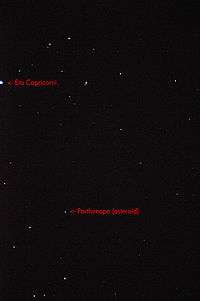11 Parthenope
Parthenope[6] (minor planet designation: 11 Parthenope) is a large, bright main-belt asteroid.
 | |
| Discovery | |
|---|---|
| Discovered by | Annibale de Gasparis |
| Discovery date | 11 May 1850 |
| Designations | |
| (11) Parthenope | |
| Pronunciation | /pɑːrˈθɛnəpiː/[1] |
Named after | Parthenopē |
| Main belt | |
| Adjectives | Parthenopean /ˌpɑːrθənəˈpiːən/, Parthenopian /pɑːrθəˈnoʊpiən/[2] |
| Orbital characteristics[3] | |
| Epoch 13 January 2016 (JD 2457400.5) | |
| Uncertainty parameter 0 | |
| Observation arc | 60281 days (165.04 yr) |
| Aphelion | 2.69837 AU (403.670 Gm) |
| Perihelion | 2.20671 AU (330.119 Gm) |
| 2.45254 AU (366.895 Gm) | |
| Eccentricity | 0.10024 |
| 3.84 yr (1402.9 d) | |
Average orbital speed | 19.02 km/s |
| 330.520° | |
| 0° 15m 23.81s / day | |
| Inclination | 4.62985° |
| 125.567° | |
| 196.005° | |
| Earth MOID | 1.19227 AU (178.361 Gm) |
| Jupiter MOID | 2.54174 AU (380.239 Gm) |
| TJupiter | 3.483 |
| Physical characteristics | |
| Dimensions | 153.3 ± 3.1 km (IRAS)[3] |
Mean radius | 76.665 ± 1.55 km |
| Mass | 6.15×1018 kg[4] |
Mean density | 3.28 ± 0.20 g/cm³[4] |
Equatorial surface gravity | 0.0578 m/s² |
Equatorial escape velocity | 0.0941 km/s |
| 13.7204 h (0.57168 d)[3] | |
| 0.1803 ± 0.007[3] | |
| Temperature | ~174 K |
| S-type asteroid[3] | |
| 8.68[5] to 12.16 | |
| 6.55[3] | |
| 0.178" to 0.057" | |
Parthenope was discovered by Annibale de Gasparis on 11 May 1850, the second of his nine asteroid discoveries. It was named after Parthenopē, one of the Sirens in Greek mythology, said to have founded the city of Naples. De Gasparis "used his utmost endeavours to realise a 'Parthenope' in the heavens, such being the name suggested by Sir John Herschel on the occasion of the discovery of Hygiea in 1849".[7]
There have been two observed Parthenopian occultations, on 13 February 1987, and 28 April 2006.
On 6 August 2008, during a perihelic opposition, Parthenope had an apparent magnitude of 8.8.
In 1988 a search for satellites or dust orbiting this asteroid was performed using the UH88 telescope at the Mauna Kea Observatories, but the effort came up empty.[8]
Based upon a light curve that was generated from photometric observations of this asteroid at Pulkovo Observatory, it has a rotation period of 13.722 ± 0.001 hours and varies in brightness by 0.10 ± 0.0s in magnitude. The light curve displays three maxima and minima per cycle.[9] The JPL Small-Body Database lists a rotation period of 13.7204 hours.[3]
Mass
In 2007, Baer and Chesley calculated a higher mass and density for Parthenope based on perturbations by the 90 km asteroid 17 Thetis. Baer and Chesley calculated a mass of 6.3×1018 kg[10] with a density of 3.3 g/cm³.[10] 2008 estimates by Baer suggest a mass of 6.15×1018.[4] The 1997 and 2001 estimates by Viateau and Rapaport were closer to 5×1018 kg with a density of 2.7 g/cm³.[10]
See also
Notes
- Noah Webster (1884) A Practical Dictionary of the English Language
- "Parthenopean". Oxford English Dictionary (3rd ed.). Oxford University Press. September 2005. (Subscription or UK public library membership required.), "Parthenopian". Oxford English Dictionary (3rd ed.). Oxford University Press. September 2005. (Subscription or UK public library membership required.)
- "JPL Small-Body Database Browser: 11 Parthenope" (2008-08-04 last obs). Retrieved 8 April 2016.
- Jim Baer (2008). "Recent Asteroid Mass Determinations". Personal Website. Archived from the original on 8 July 2013. Retrieved 6 December 2008.
- "AstDys (11) Parthenope Ephemerides". Department of Mathematics, University of Pisa, Italy. Retrieved 26 June 2010.
- Stressed on the second syllable, /pɑːrˈθɛnəpiː/ par-THEN-ə-pee.
- De Gasparis, Annibale (May 1850). "The New Planet Parthenope". Monthly Notices of the Royal Astronomical Society. 10: 144–147. Bibcode:1850MNRAS..10..145.. doi:10.1093/mnras/10.7.144.
- Gradie, J.; Flynn, L. (March 1988), "A Search for Satellites and Dust Belts Around Asteroids: Negative Results", Abstracts of the Lunar and Planetary Science Conference, 19, pp. 405–406, Bibcode:1988LPI....19..405G.
- Pilcher, Frederick (October 2011), "Rotation Period Determinations for 11 Parthenope, 38 Leda, 111 Ate 194 Prokne, 217 Eudora, and 224 Oceana", The Minor Planet Bulletin, 38 (4), pp. 183–185, Bibcode:2011MPBu...38..183P.
- Baer, James; Steven R. Chesley (2008). "Astrometric masses of 21 asteroids, and an integrated asteroid ephemeris". Celestial Mechanics and Dynamical Astronomy. Springer Science+Business Media B.V. 2007. 100 (2008): 27–42. Bibcode:2008CeMDA.100...27B. doi:10.1007/s10569-007-9103-8.
External links
- Lightcurve plot of 11 Parthenope, Palmer Divide Observatory, B. D. Warner (2008)
- IOTA (International Occultation Timing Association) occultation database
- 2011-Jan-26 Occultation / (2011 Asteroidal Occultation Results for North America)
- 11 Parthenope at AstDyS-2, Asteroids—Dynamic Site
- 11 Parthenope at the JPL Small-Body Database
